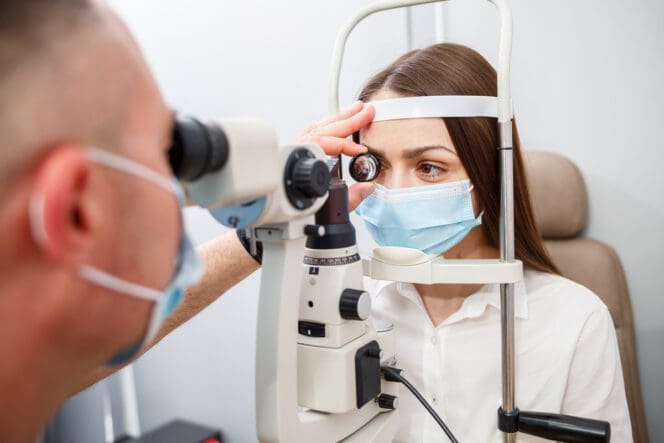If a doctor tests your eyes and the results say you have 20/30 vision, your vision is slightly worse than that of a person with normal eyesight (20/20).

A person with 20/30 vision needs to move 10 feet closer to an object than someone with 20/20 sight.
What Does 20/30 Vision Mean?
A score like 20/30 is a measurement of your visual acuity — how sharp your vision is at a distance. A score of 20/30 means that you can see things at 30 feet that people with normal vision can see from 20 feet away.
Visual acuity tests are typically performed with a Snellen chart. It is an eye chart containing letters and numbers written in different sizes. The doctor will tell you to stand 20 feet from the Snellen chart and read its letters.
The upper number represents the distance you will stand from the Snellen chart. In most cases, this distance is 20 feet (6 meters). The bottom number represents the distance a person with normal eyesight would see the letters you are reading.
Is 20/30 Vision Good?
The World Health Organization considers 20/30 to be mild vision loss. Your distance vision isn’t as clear as someone with normal vision. But you can still see many things quite well, even without glasses.
Your 20/30 visual acuity is just one part of your eye health. A comprehensive eye exam will also assess other parts of your vision, including the following:
- Peripheral vision
- Depth perception
- Binocular function
While your visual acuity may be slightly lower than normal, you may excel in these other areas. If so, you may not even notice that distant objects are slightly blurred.
When Is 20/30 Vision Not Enough?
Although 20/30 vision means having decreased optical power, it doesn’t mean blindness or anything near that. You may need help with your eyesight to accomplish some parts of your daily life without too much hassle.
But with a 20/30 vision, you can still do the following without assistance:
- Household chores
- Reading in moderate light
- Stationary exercise
Instances where 20/30 vision can limit you include the following:
- Watching movies on a big screen
- Reading text on a whiteboard
- Driving
How Can 20/30 Vision Be Corrected or Improved?
If you’re struggling with 20/30 vision, several treatment options are available. Your doctor can help you determine which is right for you and your situation.
Glasses
Using glasses is the safest and most affordable way to correct 20/30 vision. The American Academy of Ophthalmology says about 75% of adults gain normal eyesight by wearing glasses.
Glasses can be cumbersome, especially for people who swim or play sports. But they’re easy to remove and replace, as needed. And some people enjoy the fashion aspect of wearing glasses.
Contacts
Contact lenses sit on the eye’s surface, so they don’t fog up or slip down. No one will know you’re wearing them. For people who don’t like glasses, they can be an attractive option.
But contacts can be tricky in certain situations, especially if you don’t clean them properly. If you don’t care for contacts properly, it can lead to infections.
Surgeries
Refractive surgeries like LASIK, PRK, and SMILE permanently correct vision issues. If you’re a good candidate for surgery, one procedure could alter your eye’s shape, allowing for clear distance vision.
All refractive surgeries come with risks, and they’re not right for everyone. But if you want to correct 20/30 vision for good, they can be attractive. Many people who wore glasses or contacts for years find freedom and convenience with laser eye surgery.
References
-
Visual Acuity. (January 2022). American Academy of Ophthalmology.
-
Visual Acuity Test. (February 2023). U.S. National Library of Medicine.
-
Low Vision and Vision Rehabilitation. American Optometric Association.
-
Myopia (Nearsightedness). American Optometric Association.
-
Contact Lens Risks. (September 2018). U.S. Food and Drug Administration.
-
What Is Refractive Surgery? (February 2023). American Academy of Ophthalmology.
-
Visual Acuity. (May 2023). StatPearls.
-
Risk Behaviors for Contact Lens–Related Eye Infections Among Adults and Adolescents — United States, 2016. (August 2017). Morbidity and Mortality Weekly.
Last Updated October 5, 2023
Note: This page should not serve as a substitute for professional medical advice from a doctor or specialist. Please review our about page for more information.